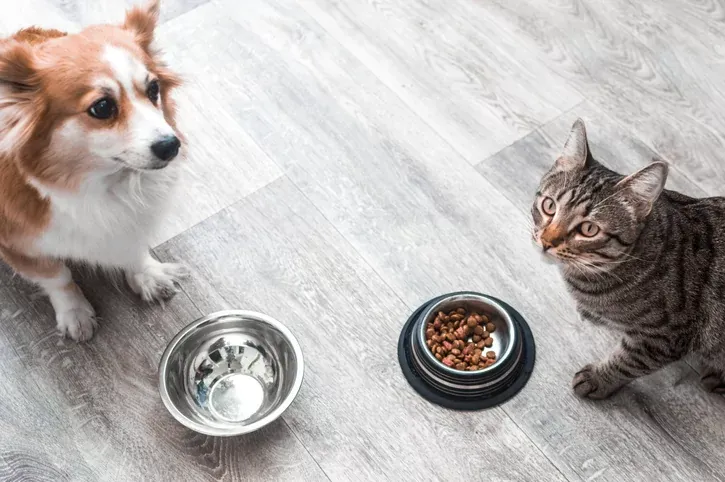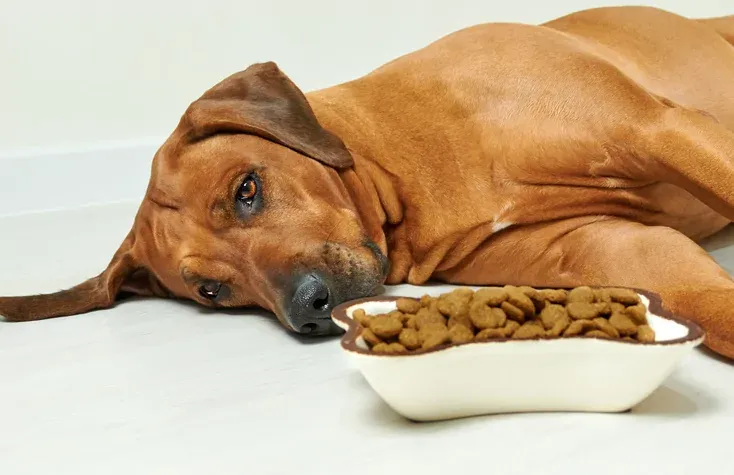Having both a dog and a cat at home often leads to mix-ups, like your dog sneaking a bite of the cat’s kibble. If your dog eats cat food by accident, you’re not alone—many pet owners face this. The good news? It’s usually safe in small amounts, but understanding the risks helps you respond wisely. In this guide, we’ll cover symptoms to watch, potential issues like pancreatitis, and prevention tips to keep your pets healthy.
Cat food is higher in protein and fat for feline needs, not canine digestion. Occasional nibbles rarely cause harm, but regular access can lead to problems. For more on what food dog can not eat, check our related guide to stay informed on pet-safe eating.
Don’t Panic: It’s Common and Often Harmless
First, stay calm—dogs eating cat food happens frequently and isn’t typically dangerous. Pets have shared bowls accidentally for years without major issues. Monitor your dog for 24-48 hours; if they’re acting normal, no vet visit is needed.
According to the American Kennel Club (AKC), minor incidents like this resolve quickly. Your dog’s size matters too—larger breeds handle a few bites better than small ones. Keep an eye on energy levels and appetite during this time.
 What Should I Do if my Dog Eats Cat Food in oxford, ms
What Should I Do if my Dog Eats Cat Food in oxford, ms
Monitor for Digestive Upset
The most common reaction is tummy trouble. Expect possible nausea, vomiting, diarrhea, or loose stools as cat food’s rich formula disrupts a dog’s gut bacteria. Your pup might seem lethargic or uncomfortable, refusing playtime or walks.
These symptoms usually fade within a day or two with rest and hydration. Offer plenty of fresh water and bland food like boiled chicken and rice if needed. Persist beyond 48 hours, or if you see blood in stool/vomit or swelling (allergic signs), contact your vet immediately. PetMD notes early intervention prevents dehydration.
For broader insights, explore our list of what dogs can t eat list to avoid future surprises.
Be Alert for Pancreatitis Risks
Rarely, high-fat cat food triggers pancreatitis in sensitive dogs. This inflammation of the pancreas causes severe pain, hunched back, swollen belly, profuse vomiting, and bloody diarrhea. Breeds like Miniature Schnauzers or those with prior episodes are at higher risk.
Pancreatitis can be life-threatening without prompt treatment, often requiring IV fluids and hospitalization. Vets diagnose via blood tests; prevention starts with species-appropriate diets. Always consult a professional if symptoms appear—don’t wait.
 Dog Eats Cat Food
Dog Eats Cat Food
Prevent Future Incidents: Relocate the Cat Food
Easy access invites trouble, so elevate or hide cat bowls. Place food on high counters or in rooms dogs can’t enter. This simple change eliminates most risks permanently.
From experience, many multi-pet homes succeed with puzzle feeders for cats—slowing intake while deterring dogs. It’s a vet-recommended strategy for harmony.
Feed Pets Separately for Peace
Separate feeding spaces work wonders. Feed cats on elevated shelves or closed rooms during mealtimes. Supervise until habits stick, reducing vomit cleanups and stress.
This mimics natural behaviors: cats prefer privacy, dogs eat quickly. Rotate spots if needed for fairness.
Learn more about safe options in what foods are safe for puppies to eat, especially for young or mixed households.
Secure Food with Smart Storage
For persistent poachers, switch to airtight containers with locking lids. These block dogs (and pests) effectively, keeping kibble fresh longer.
Gamma2 Vittles Vault or IRIS brands are popular, affordable choices. Store in pantries away from pet zones. Bulk buying saves money while prioritizing safety.
Long-Term Diet Tips for Multi-Pet Homes
Beyond prevention, balance nutrition: dogs need carbs and lower protein than cats. Chronic cat food consumption leads to obesity, nutrient imbalances, or urinary issues. Stick to AAFCO-approved dog formulas.
Consult vets for personalized plans, especially with allergies. Regular check-ups catch predispositions early.
See details on risky proteins like what meat should all dogs avoid and what is the one meat all dogs should avoid.
Conclusion
Your dog eating cat food occasionally is low-risk, but vigilance for digestive woes or pancreatitis is key. Quick prevention like elevated bowls and secure storage ensures happy, healthy pets. Prioritize proper diets for long-term vitality—your furry friends depend on it.
If concerns arise, reach out to a vet promptly. Share your experiences in comments and explore more dog care tips on our site!
References:
- American Kennel Club (AKC): Dog Diarrhea Guide
- PetMD: Pancreatitis in Dogs
